[English] 日本語
 Yorodumi
Yorodumi- PDB-2iok: Human estrogen receptor alpha ligand-binding domain in complex wi... -
+ Open data
Open data
- Basic information
Basic information
| Entry | Database: PDB / ID: 2iok | ||||||
|---|---|---|---|---|---|---|---|
| Title | Human estrogen receptor alpha ligand-binding domain in complex with compound 1D | ||||||
 Components Components | Estrogen receptor | ||||||
 Keywords Keywords | TRANSCRIPTION / NUCLEAR RECEPTOR / TRANSCRIPTION FACTOR / ER-ALPHA / ANTAGONIST | ||||||
| Function / homology |  Function and homology information Function and homology informationregulation of epithelial cell apoptotic process / antral ovarian follicle growth / G protein-coupled estrogen receptor activity / regulation of branching involved in prostate gland morphogenesis / RUNX1 regulates transcription of genes involved in WNT signaling / RUNX1 regulates estrogen receptor mediated transcription / regulation of toll-like receptor signaling pathway / nuclear estrogen receptor activity / prostate epithelial cord arborization involved in prostate glandular acinus morphogenesis / epithelial cell proliferation involved in mammary gland duct elongation ...regulation of epithelial cell apoptotic process / antral ovarian follicle growth / G protein-coupled estrogen receptor activity / regulation of branching involved in prostate gland morphogenesis / RUNX1 regulates transcription of genes involved in WNT signaling / RUNX1 regulates estrogen receptor mediated transcription / regulation of toll-like receptor signaling pathway / nuclear estrogen receptor activity / prostate epithelial cord arborization involved in prostate glandular acinus morphogenesis / epithelial cell proliferation involved in mammary gland duct elongation / prostate epithelial cord elongation / epithelial cell development / negative regulation of smooth muscle cell apoptotic process / uterus development / mammary gland branching involved in pregnancy / vagina development / TFIIB-class transcription factor binding / steroid hormone receptor signaling pathway / androgen metabolic process / cellular response to estrogen stimulus / mammary gland alveolus development / estrogen response element binding / Mitochondrial unfolded protein response (UPRmt) / nuclear receptor-mediated steroid hormone signaling pathway / Nuclear signaling by ERBB4 / RNA polymerase II preinitiation complex assembly / protein localization to chromatin / estrogen receptor signaling pathway / negative regulation of canonical NF-kappaB signal transduction / steroid binding / 14-3-3 protein binding / TFAP2 (AP-2) family regulates transcription of growth factors and their receptors / TBP-class protein binding / nitric-oxide synthase regulator activity / positive regulation of nitric-oxide synthase activity / negative regulation of miRNA transcription / ESR-mediated signaling / positive regulation of DNA-binding transcription factor activity / transcription coregulator binding / transcription corepressor binding / nuclear estrogen receptor binding / negative regulation of DNA-binding transcription factor activity / stem cell differentiation / SUMOylation of intracellular receptors / cellular response to estradiol stimulus / transcription coactivator binding / euchromatin / beta-catenin binding / Nuclear Receptor transcription pathway / response to estrogen / nuclear receptor activity / positive regulation of fibroblast proliferation / male gonad development / Constitutive Signaling by Aberrant PI3K in Cancer / Regulation of RUNX2 expression and activity / sequence-specific double-stranded DNA binding / positive regulation of nitric oxide biosynthetic process / Ovarian tumor domain proteases / response to estradiol / PIP3 activates AKT signaling / ATPase binding / positive regulation of cytosolic calcium ion concentration / DNA-binding transcription activator activity, RNA polymerase II-specific / PI5P, PP2A and IER3 Regulate PI3K/AKT Signaling / regulation of inflammatory response / fibroblast proliferation / phospholipase C-activating G protein-coupled receptor signaling pathway / transcription regulator complex / Estrogen-dependent gene expression / DNA-binding transcription factor activity, RNA polymerase II-specific / Extra-nuclear estrogen signaling / calmodulin binding / chromatin remodeling / RNA polymerase II cis-regulatory region sequence-specific DNA binding / DNA-binding transcription factor activity / negative regulation of gene expression / chromatin binding / regulation of DNA-templated transcription / regulation of transcription by RNA polymerase II / protein kinase binding / chromatin / positive regulation of DNA-templated transcription / enzyme binding / negative regulation of transcription by RNA polymerase II / Golgi apparatus / signal transduction / positive regulation of transcription by RNA polymerase II / protein-containing complex / zinc ion binding / nucleoplasm / identical protein binding / nucleus / membrane / plasma membrane / cytosol / cytoplasm Similarity search - Function | ||||||
| Biological species |  Homo sapiens (human) Homo sapiens (human) | ||||||
| Method |  X-RAY DIFFRACTION / X-RAY DIFFRACTION /  MOLECULAR REPLACEMENT / Resolution: 2.4 Å MOLECULAR REPLACEMENT / Resolution: 2.4 Å | ||||||
 Authors Authors | Fitzgerald, P.M.D. / Sharma, N. | ||||||
 Citation Citation |  Journal: Bioorg.Med.Chem.Lett. / Year: 2007 Journal: Bioorg.Med.Chem.Lett. / Year: 2007Title: Estrogen receptor ligands. Part 16: 2-Aryl indoles as highly subtype selective ligands for ERalpha Authors: Dykstra, K.D. / Guo, L. / Birzin, E.T. / Chan, W. / Yang, Y.T. / Hayes, E.C. / DaSilva, C.A. / Pai, L.-Y. / Mosley, R.T. / Kraker, B. / Fitzgerald, P.M.D. / DiNinno, F. / Rohrer, S.P. / ...Authors: Dykstra, K.D. / Guo, L. / Birzin, E.T. / Chan, W. / Yang, Y.T. / Hayes, E.C. / DaSilva, C.A. / Pai, L.-Y. / Mosley, R.T. / Kraker, B. / Fitzgerald, P.M.D. / DiNinno, F. / Rohrer, S.P. / Schaeffer, J.M. / Hammond, M.L. | ||||||
| History |
|
- Structure visualization
Structure visualization
| Structure viewer | Molecule:  Molmil Molmil Jmol/JSmol Jmol/JSmol |
|---|
- Downloads & links
Downloads & links
- Download
Download
| PDBx/mmCIF format |  2iok.cif.gz 2iok.cif.gz | 104.9 KB | Display |  PDBx/mmCIF format PDBx/mmCIF format |
|---|---|---|---|---|
| PDB format |  pdb2iok.ent.gz pdb2iok.ent.gz | 80.1 KB | Display |  PDB format PDB format |
| PDBx/mmJSON format |  2iok.json.gz 2iok.json.gz | Tree view |  PDBx/mmJSON format PDBx/mmJSON format | |
| Others |  Other downloads Other downloads |
-Validation report
| Arichive directory |  https://data.pdbj.org/pub/pdb/validation_reports/io/2iok https://data.pdbj.org/pub/pdb/validation_reports/io/2iok ftp://data.pdbj.org/pub/pdb/validation_reports/io/2iok ftp://data.pdbj.org/pub/pdb/validation_reports/io/2iok | HTTPS FTP |
|---|
-Related structure data
| Related structure data | 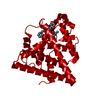 2iogC  1ertS C: citing same article ( S: Starting model for refinement |
|---|---|
| Similar structure data |
- Links
Links
- Assembly
Assembly
| Deposited unit | 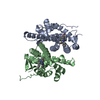
| ||||||||
|---|---|---|---|---|---|---|---|---|---|
| 1 |
| ||||||||
| Unit cell |
|
- Components
Components
| #1: Protein | Mass: 28976.100 Da / Num. of mol.: 2 / Fragment: Steroid-binding region, residues 306-554 Source method: isolated from a genetically manipulated source Source: (gene. exp.)  Homo sapiens (human) / Gene: ESR1, ESR, NR3A1 / Production host: Homo sapiens (human) / Gene: ESR1, ESR, NR3A1 / Production host:  #2: Chemical | #3: Water | ChemComp-HOH / | |
|---|
-Experimental details
-Experiment
| Experiment | Method:  X-RAY DIFFRACTION / Number of used crystals: 1 X-RAY DIFFRACTION / Number of used crystals: 1 |
|---|
- Sample preparation
Sample preparation
| Crystal | Density Matthews: 2.41 Å3/Da / Density % sol: 48.88 % |
|---|
-Data collection
| Diffraction source | Source:  ROTATING ANODE / Type: OTHER / Wavelength: 1.54 Å ROTATING ANODE / Type: OTHER / Wavelength: 1.54 Å |
|---|---|
| Radiation | Protocol: SINGLE WAVELENGTH / Monochromatic (M) / Laue (L): M / Scattering type: x-ray |
| Radiation wavelength | Wavelength: 1.54 Å / Relative weight: 1 |
| Reflection | Resolution: 2.4→49.9 Å / Num. obs: 20663 |
- Processing
Processing
| Software |
| |||||||||||||||||||||||||||||||||
|---|---|---|---|---|---|---|---|---|---|---|---|---|---|---|---|---|---|---|---|---|---|---|---|---|---|---|---|---|---|---|---|---|---|---|
| Refinement | Method to determine structure:  MOLECULAR REPLACEMENT MOLECULAR REPLACEMENTStarting model: PDB entry 1ert Resolution: 2.4→10 Å / Cross valid method: THROUGHOUT Details: THE DATA ARE MEROHEDRALLY TWINNED THE REFINED TWINNING RATIO (SHELXL) IS 0.398
| |||||||||||||||||||||||||||||||||
| Refinement step | Cycle: LAST / Resolution: 2.4→10 Å
| |||||||||||||||||||||||||||||||||
| Refine LS restraints |
|
 Movie
Movie Controller
Controller


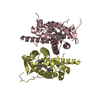
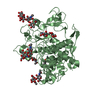


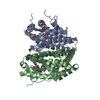
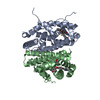
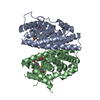



 PDBj
PDBj







